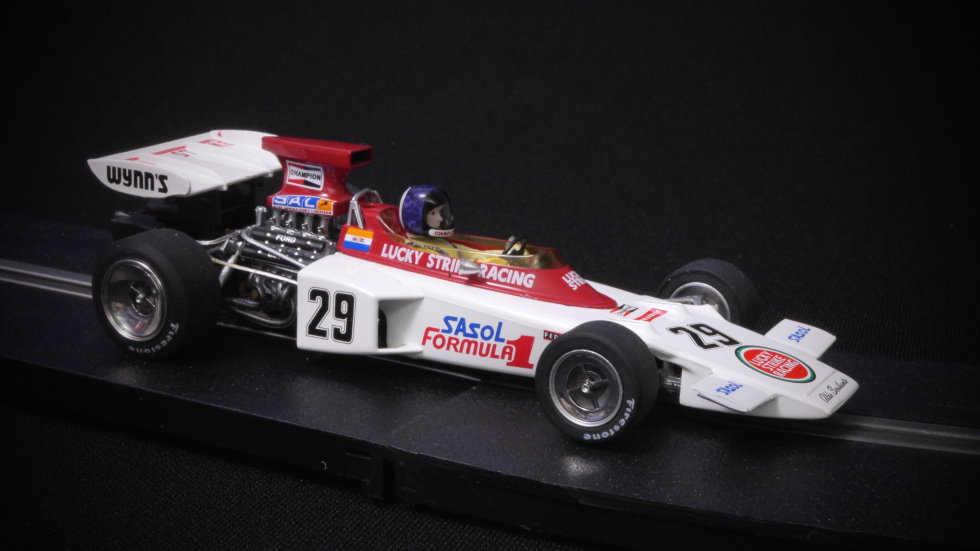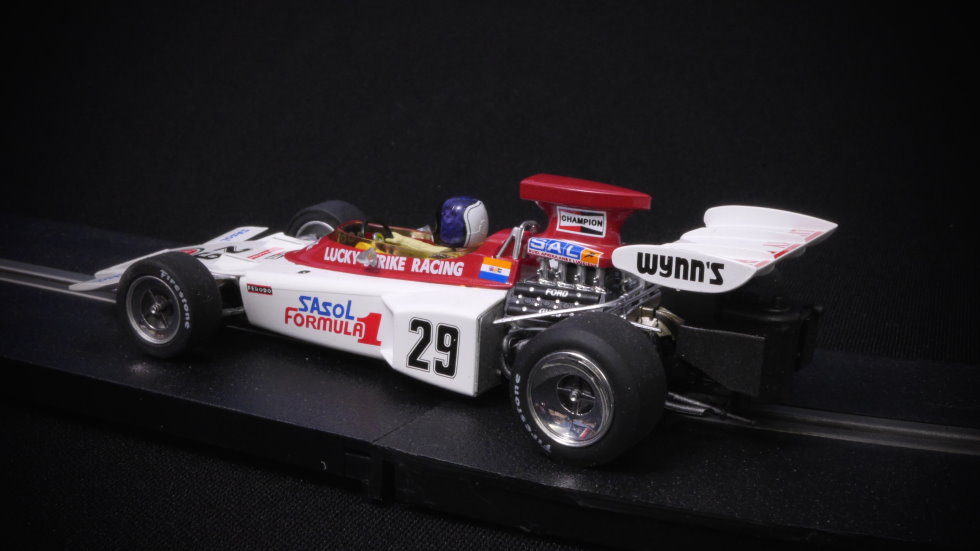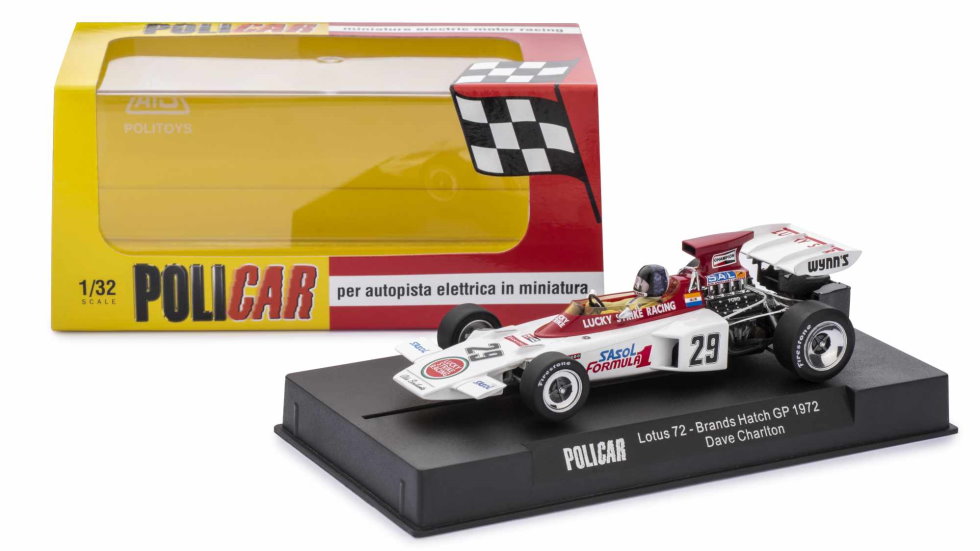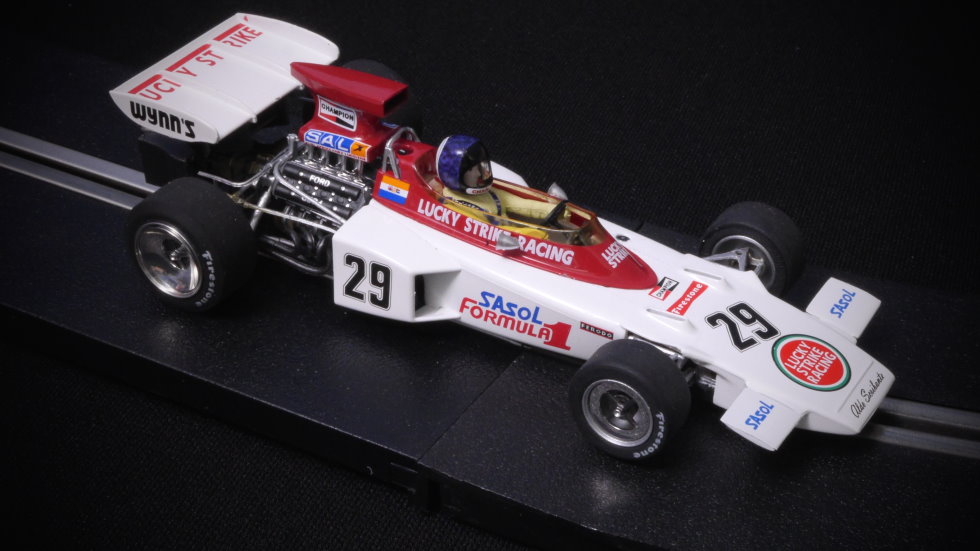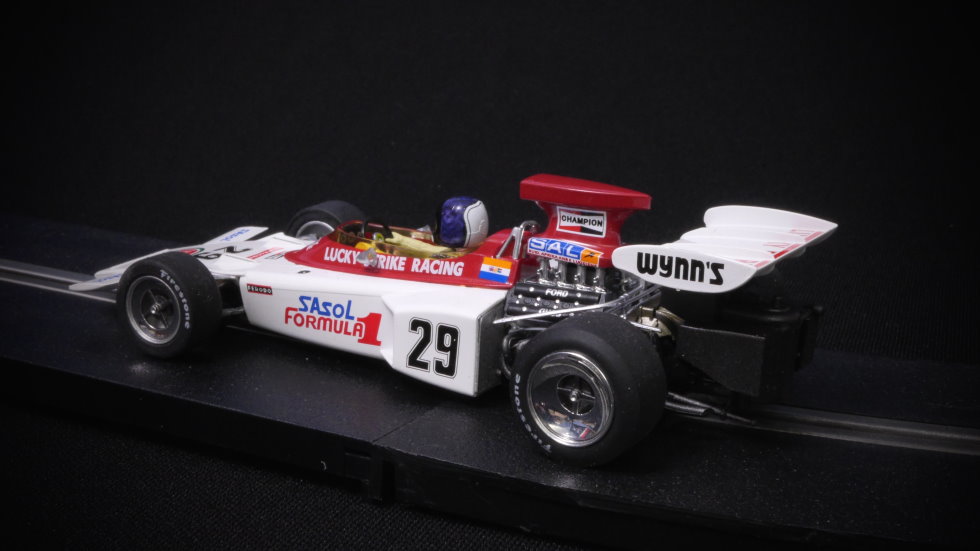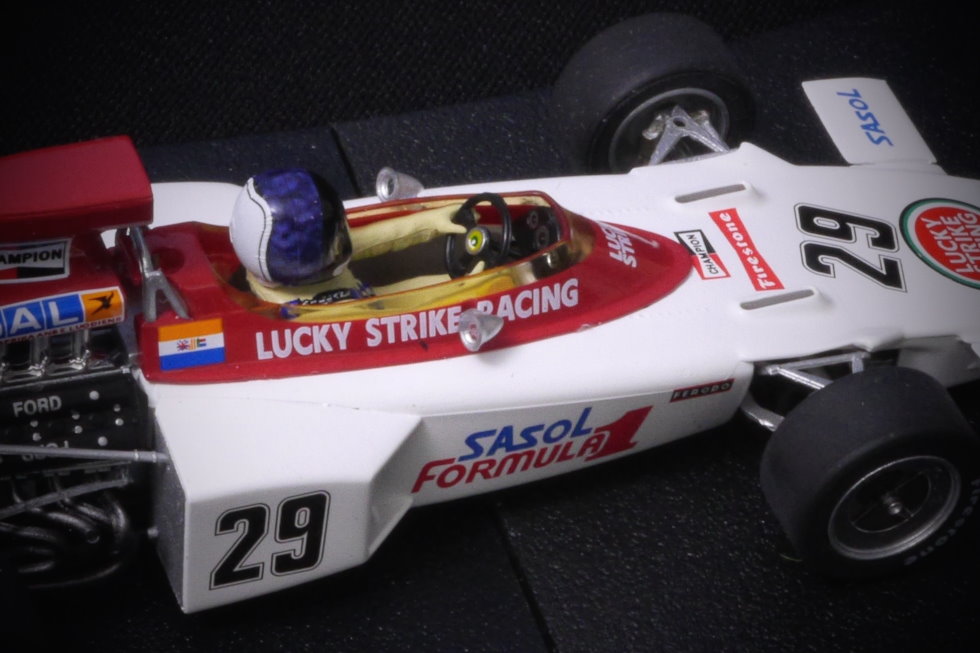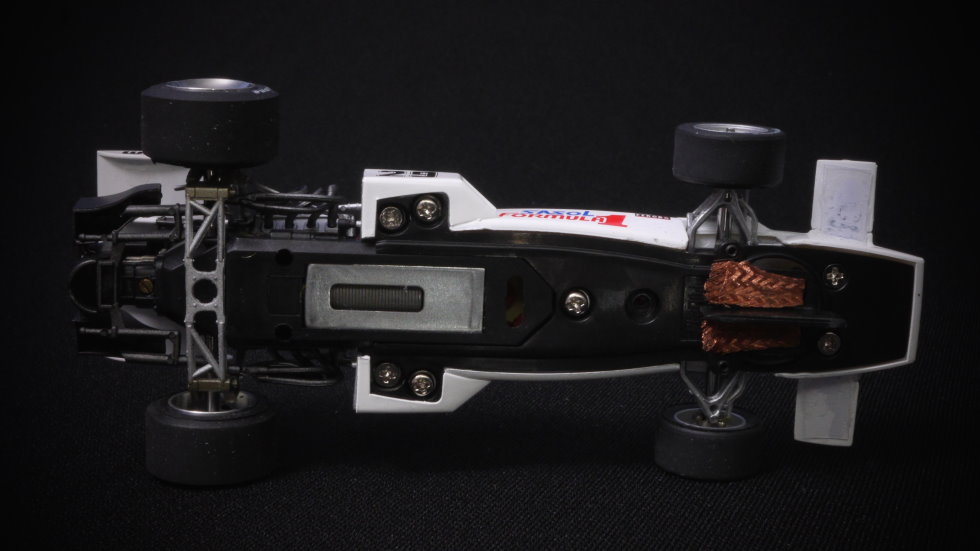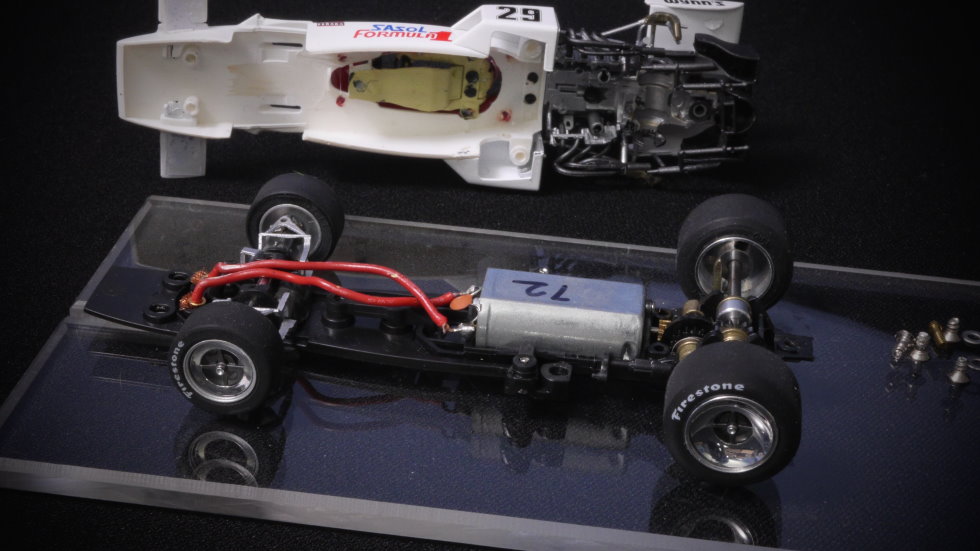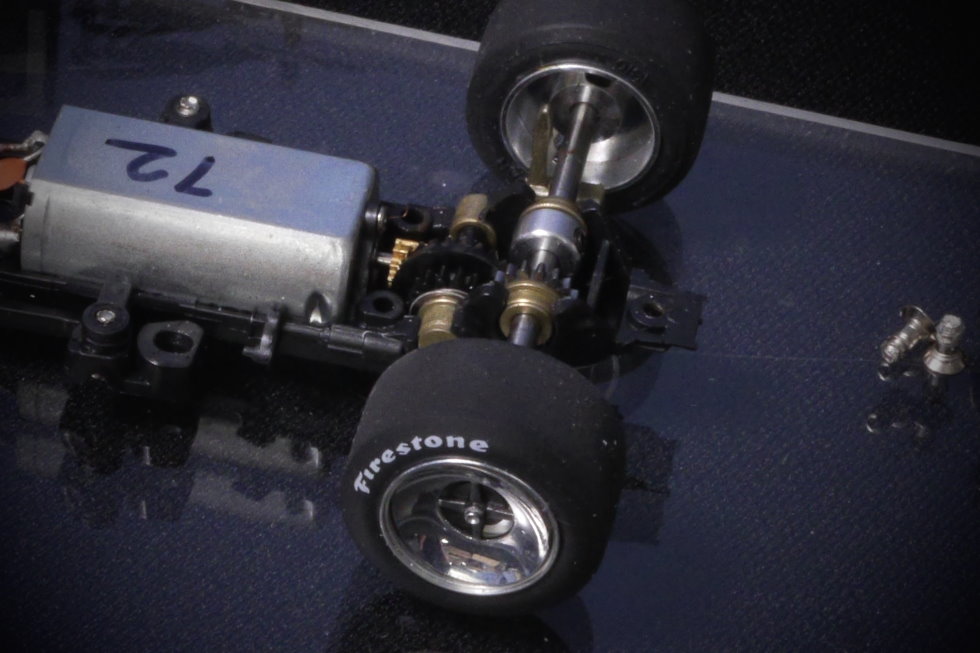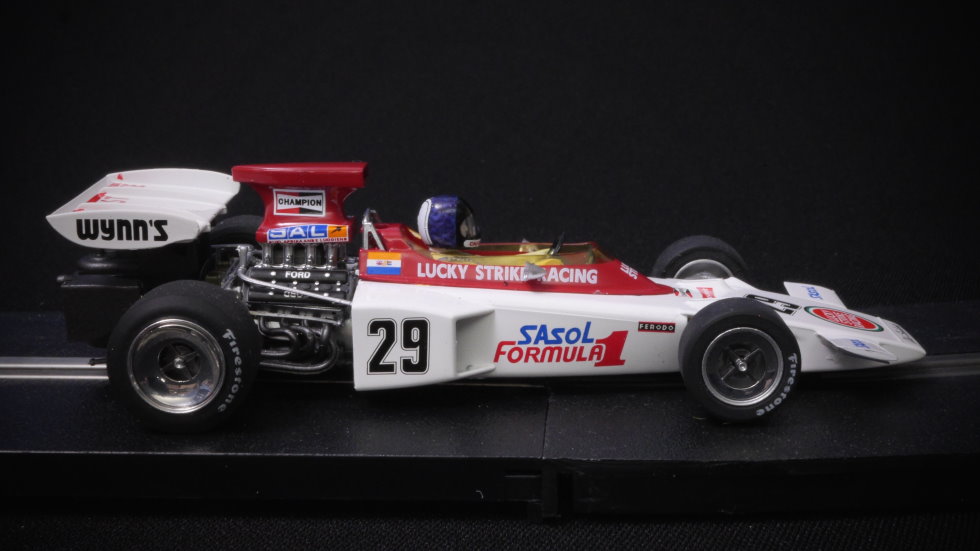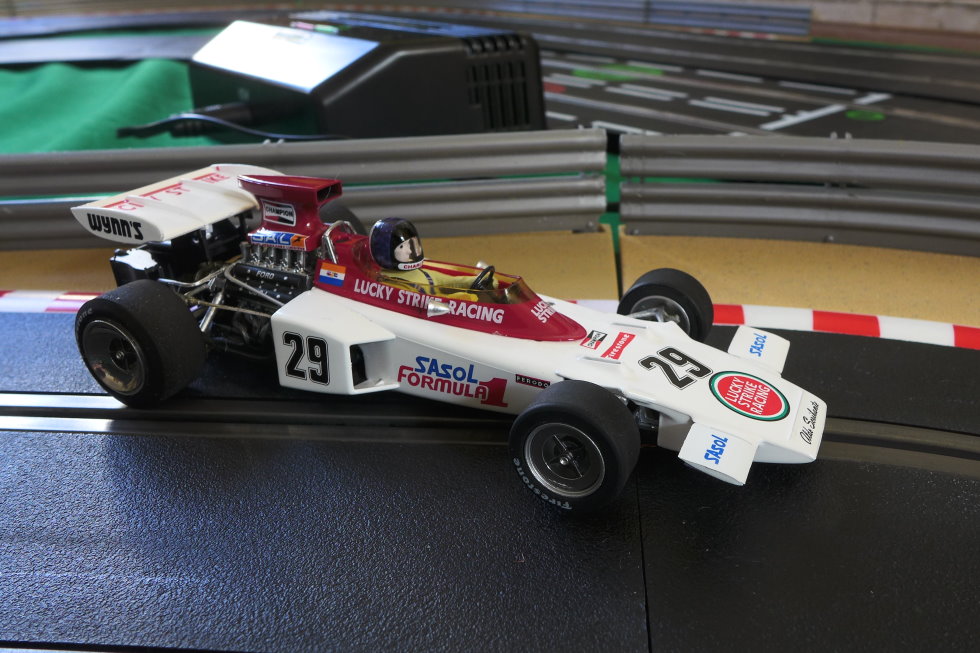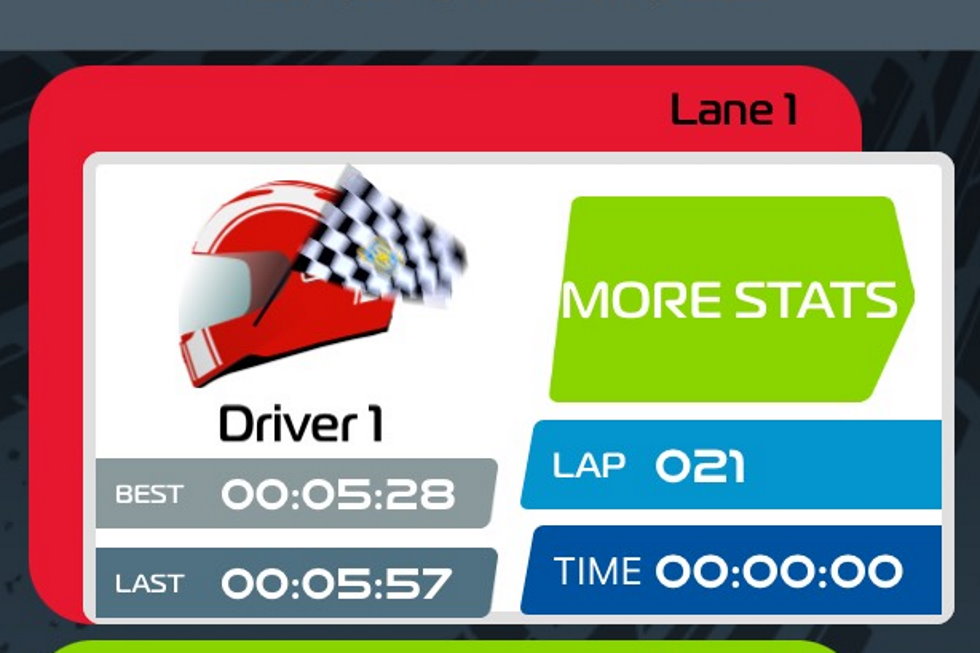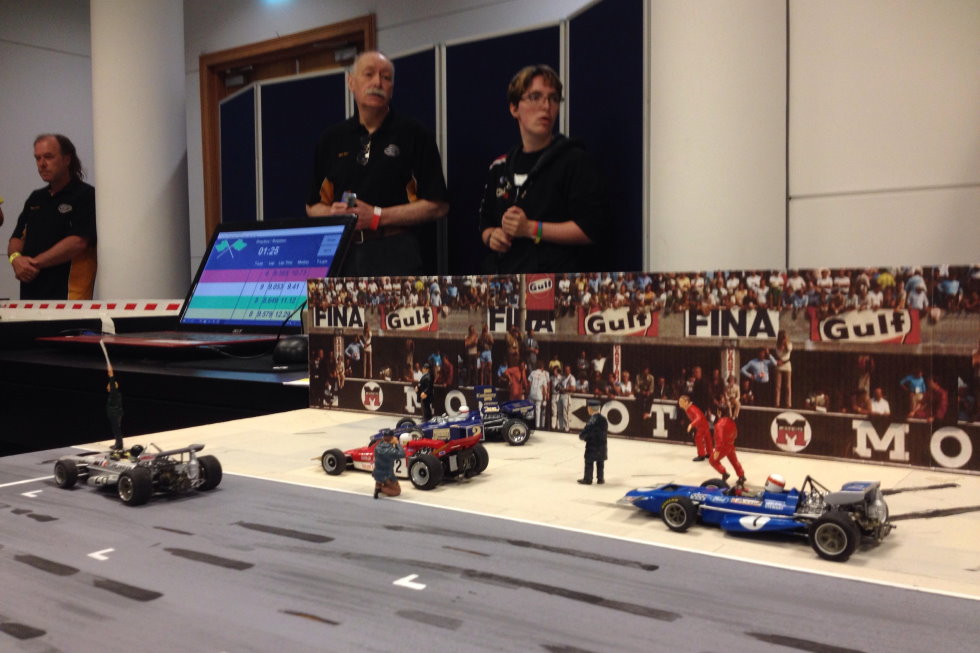We continue our look at performance slot cars with a review of a Policar model…
After a brief introduction (here), I’m now focusing on one model from of NSR, Policar and Slot.it. The three cars I’ve chosen are – I think – good introductions to the brands. Each is fun to drive on Scalextric home tracks and their performance won’t be too challenging for those of us more used to standard Scalextric cars.
The Policar model I’ve chosen is the fabulous Lotus 72 from their ‘Formula 1’ range of early 1970 Grand Prix cars. The livery on my Lotus isn’t the classic JPS black and gold, but a relatively obscure South African entrant. The red and white Lucky Strike colours are pretty special though. As well as looking fantastic, these Policar models are the most competitive ‘classic’ Formula One cars raced at UK slot car clubs – the unique Policar gearbox tames the powerful slim-can motor for superb driveability. My Lotus 72 was bought and prepared for that purpose.
If you like the look of this car, it’s available to buy here: https://www.jadlamracingmodels.com/policar-1-32-slot-car-lotus-72-no-29-brands-hatch-gp-1972-dave-charlton-car02e/.
Another – slightly newer – Embassy-sponsored Lotus 72 is here: https://www.jadlamracingmodels.com/policar-lotus-72d-no-2-south-africa-championship-1975-1-32-car02f/. There are two of the latest March 701 cars with an updated chassis – the 1971 Jean-Pierre Jarier car: https://www.jadlamracingmodels.com/policar-march-701-no-26-monza-1971-1-32-car04d/ and John Love’s Team Gunston racer from the 1971 South African championship: https://www.jadlamracingmodels.com/policar-march-701-no-24-kyalami-1971-1-32-car04e/. And if you fancy a Ferrari, there’s a choice of two – Jacky Ickx: https://www.jadlamracingmodels.com/policar-312b2-no-2-1st-zandvoort-1971-1-32-car05a/ or Clay Regazzoni: https://www.jadlamracingmodels.com/policar-ferrari-312b2-no-5-silverstone-1971-1-32-car05b/. All three models – Lotus, March and Ferrari – are also available as white kits with an assembled ‘rolling’ chassis.
Who Are Policar?
The original Policar company – along with stable-mate Polistil – made the most popular slot cars sold in Italy during the 1960s, 70s and 80s. It wouldn’t be far off the truth to say they were the Italian ‘Scalextric’ – everyone knew the brand names and what they stood for. Like many traditional toy companies, Policar and Polistil struggled in the 80s and pretty much ceased production of slot cars in the 90s. The Polistil brand were bought by Chinese company Maisto, who have continued to make cheap, basic slot car sets under the Polistil and Maisto brands.
Italian company Galileo Engineering, the owners of Slot.it, took over the Policar name and relaunched the brand in 2017. Two re-badged Slot.it Ferraris – a classic 512PB sports prototype and the 1990s F40 race car – were in the catalogue, together with two completely new 1970s Formula One cars, the March 701 and Lotus 72. These Formula One cars set a new benchmark for performance, utilising a clever three-gear transmission and modular chassis that was developed in conjunction with British enthusiast Andi Rowland.
Since that launch, the Policar range has grown to include more single-seaters – including a modern generic ‘Monoposto’ F1 car – more classic Ferraris, a range of low-budget ‘Home Racers’ touring cars and the high-quality Policar track system. All come in cool retro Policar packaging.
The Real Lotus 72
Designed by Colin Chapman and Maurice Phillipe, the Lotus 72 was completely revolutionary when it first appeared midway through the 1970 Formula One season. Its highly-aerodynamic wedge shape was influenced by Phillipe’s Lotus 56 Indianapolis car and the futuristic lines of the Gold Leaf-sponsored Lotus were a big hit with the fans. Some of the mechanical innovations – particularly the suspension system and inboard brakes – need development work, but Jochen Rindt took the 72 to four successive Grand Prix victories to put him a commanding lead in the championship. Rindt tragically died during qualifying at Monza, but had enough points to become Formula One’s first posthumous champion.
The Lotus 72 continued to be developed and refined. After a lean year in 1971, Emerson Fittipaldi won back-to-back titles in the iconic black and gold JPS-sponsored car. By 1974, the Lotus 72 was getting rather long-in-the-tooth, but Ronnie Peterson bagged three wins. There were no victories in its final season in 1975 – amazingly its sixth as the Team Lotus works entry.
The Lotus 72 was also entered into Grand Prix by private teams – such as Rob Walker’s Brook Bond Oxo Racing team in 1970 and the Lucky Strike-sponsored Scuderia Scribante team in 1972, 73 and 74. This is the car modelled by Policar and was driven by Dave Charlton in just a handful of Grand Prix without scoring any points. Both the team and the driver were South African – and Charlton won their local Formula One championship six years in succession between 1970 and 1975, the Lotus 72 being the ride for plenty of race wins.
The Policar Model
The Lucky Strike model was the fourth of five Lotus 72 releases, appearing in 2018. Each of the five models is different, making them near perfect replicas of the individual racing cars. The one we’re looking at here is modelled on the Lotus 72D raced by Dave Charlton in the 1972 British Grand Prix at Brands Hatch. He qualified twenty-fourth in a field of twenty-seven, but retired with gearbox problems on lap 21.
Looking at the Policar Lotus 72, what strikes me is the beauty of the model. I think the shape, the stance and the detailing makes it a better scale model than the Scalextric version, even though that is a very fine car too. The Ford Cosworth DFV engine is stunning – especially the exhaust pipes – and the airbox sits perfectly at the slightly jaunty angle of the original car, complete with the oversized SAL – Suid-Afrikaanse Lugdiens – sticker. The gearbox cover, oil radiators and pipework sit under an accurate rendition of the 1972 rear wing – although the wing is sitting a little bit too high compared with photos from the Brands Hatch race.
The driver figure has loads of great features, including a separate helmet that sits over his head. The inside of the cockpit is full of lovely detail too. The suspension is nicely done – front and back – and the wheel inserts accurate for 1972. Some of the photos I’ve seen suggest the rear wheel hubs were white at some races, but the ones on the Policar model were certainly used on the Lucky Strike car from time to time.
The decoration is almost as good as the moulding. There are a couple of paint blemishes on the inside of the side radiator intakes, but that’s all I can find to be picky about. This is a stunning scale model – plus a performance slot car too. It’s time to take a look inside…
The Mechanical Stuff
The first thing to say, is the Lotus is not an easy car to get into – although much easier than some other classic F1 models. There are two screws at the front to remove and then a choice of four either side of the motor. Two hold the body and two hold the motor pod – we want to remove the two further back. And then we’re still not done – there’s a tiny grub screw towards the back of the gearbox which, on my car, was removed with a small flat-headed screwdriver. With these five screws removed, the body should come off, but be careful of the exhaust pipes around the rear axle – they are actually in two pieces, so should part in the middle quite nicely.
Inside, we have a narrow two-piece chassis – and no traction magnet. The motor pod is common to all Policar F1 cars and holds the slim-can motor and uniquely complex Policar gearbox. The front piece of the chassis holds just the front axle and guide. There are two positions at the front of the motor pod where it can be screwed to the chassis. Both should be loosened a little – or the front screw removed, which is what I have done. The screws at the side of the motor should also be loosened to give some side-to-side float and a little (but not much) up-and-down movement.
The guide moves nicely, but the standard motor cable is a little thick. This can interfere with the front axle and some racers replace the cable with thinner wire. The suspension detail can also interfere with the axle and wheels. What I found helped was a little trimming of the suspension and using some grub screws to set the height of the axle.
The main interest inside any Policar F1 model is the motor and gearbox. This set-up is an ingenious solution to a universal problem with the slim-can motor. Even with a traction magnet fitted, Scalextric F1 cars with a slim-can ‘FF’ motor can be a bit of a handful to drive. Because of limited space, it is an ideal fit for a single-seater, but the power curve of the motor is brutal. Take the traction magnets out and the cars tend to be undriveable. Most non-mag classic F1 fans either change the Scalextric motor for a less powerful one or reduce the track voltage down to 9 volts or less. However, shouldn’t F1 be all about handling huge amounts of power?
What Policar – and Andi Rowland – did was to create a gearbox that keeps the power of the motor (Policar use their own motor – which is faster than the Scalextric one), but tame it with a more refined gearbox. This uses four gears – pinion, crown, plus two spur gears – to take the edge off the low-end torque. It is possible to change the final gear to give more speed (16T) or more acceleration (18T), but what the standard ratio of 9:21:16:17 gives is smooth and progressive power delivery on standard 12 to 14v power – and with standard controllers.
The gearbox is also long and thin – perfect to hide away under a realistic gearbox cover, giving both authentic looks and performance. Policar call it their ‘Hewland FG400’ – evoking the gearbox that was traditionally paired so successfully with the Ford Cosworth. The Policar motor pod and gearbox has become the drivetrain of choice in classic F1 racing. Some small ‘artisan’ manufacturers have used it with permission – plus Andi Rowland has made available 3D printed replacement chassis for many Scalextric ‘Legends’ F1 cars so they can be fitted with the Policar pod and gearbox. You can find them in his ‘Arco’ store at Shapeways.
Next, let’s have a look at wheels and tyres. Unlike Slot.it cars – which come with aluminium rear wheels – Policar models have plastic wheels all round. Suitable aluminium hubs and the correct inserts are available as spares. The plastic wheels are good quality and perfectly sufficient for home and club racing, but many racers choose to swap them for the aluminium hubs. For the classic F1 cars like the Lotus, the part number is PW16011724a (buy them here: https://www.jadlamracingmodels.com/policar-by-slot-it-al-16×11-7-early-70s-f1-rear-wheels-2-pw16011724a/). The plastic wheels are push-on, pull-off – whereas the aluminium hubs are fixed using a grub screw. Policar and Slot.it use the same M2 screws and require a 0.9mm allen key or hex screwdriver. The Slot.it PA76 torque driver is a superb piece of kit – or the Gaugemaster GM592 Slot Car Tool Set is a good value set of screwdrivers to cover all performance brands, plus a pinion puller/press tool for changing a pinion gear on a motor.
Of course, you’ll want to have your wheels looking like proper Lotus 72 wheels – and that requires wheel inserts. You can remove the inserts from the original plastic wheels and fit them to the new ones (ideally better than I did!), or buy replacement inserts (PC-S02I), which will require painting.
In terms of tyres, the standard tyres are Slot.it’s C1 compound and should be perfectly fine for Scalextric and other plastic tracks. Spare treaded and slick tyres in this compound are available. There is also a softer compound – F22 – that is available in a slick tyre, which is more suitable for club wood tracks and high-grip plastic tracks like Policar and Ninco. I’ve kept the the C1 slicks on my Lotus.
The Policar website (http://www.policar.it/) has details of suitable tuning parts on the listing of each model. There is also a pdf document available for each model explaining how it goes together – an interesting and important read!
One final thought is on digital… How easy is it to chip these cars for Scalextric digital compatibility? I haven’t converted this car for digital running – for me, it’s an analogue racer. With some skill and imagination, it would be possible to fit a small chip – Slot.it 0201c1 or Scalextric C8516, removed from its plastic flap – between the front axle and the motor. It will require trimming the body, cockpit and suspension, plus removing the forward screw post of the motor pod entirely. If I ever try, I shall write a post about it!
Preparation
Essential preparation for any performance slot car is lubrication. On the Lotus, I simply add a drop of oil to where the axle goes through the brass bushings and on all the gears and moving parts in the Policar gear box. On some cars (including mine), the gearbox can be a little tight to begin with. Lubrication and moving the axle stopper helps, but the main things is letting everything run until it loosens up. Otherwise, a slight spreading and lifting of the ends of pick-up braids helps with conductivity with the track rails. Scuffing up the rear tyres is also a good idea – as I explained in Part 2 of my Scalextric Tuning series. Loosening of the body screws is not necessary, but loosening of the motor pod screws is (as described above).
When you put the car back together, do take care of the exhaust pipes. These need to go underneath the axle, otherwise they will press on the axle, causing friction and reducing performance. The pipes are reasonably flexible, so can withstand quite firm handling – I haven’t broken one yet…
Track Performance
I remember the Lotus was a lot of fun out-of-the box when I bought it. To prepare it for some club racing, I did add the aluminium rear wheels, trued the tires and tidied up the wiring – all of which might improve the performance a small amount. It was exciting to get the Lotus back on track at home.
The small and twisty Jadlam SL6 layout was always going to be a challenge for a non-magnet car, but once I got into a good rhythm, I really enjoyed it. The Lotus was driving like it would in real life on such a tight layout – a lot of sideways action! Yet the car was always under control – the big tires were using up all the track and most of the borders, picking up dirt and losing traction. Racing these cars on the low-grip Scalextric Sport track definitely requires regular pit-stops for a tire clean. That’s something that could easily be built into an ARC Air race format.
Setting up a couple of two-minute test runs with the ARC app, I started with 21 laps and a fast time of 5.44 seconds. I then followed that with another 21 laps and a quick lap of 5.28 seconds. I thought that was really rather impressive compared to my NSR Porsche 908/3s best non-mag time of 5.24. These Policar F1 cars perform best when they can stretch their legs a bit – but the Lotus proved they also work well on the twisty stuff.
My Lucky Strike Lotus 72 is ready and waiting for some club racing. However, these models also make awesome non-magnet home racing cars. The Lotus 72 is considered the best of the bunch, but the Galileo Engineering team have redesigned the chassis for the March 701 to make it competitive – and the new Ferrari 312 B2 is reported to be right up there too. Policar classic F1s run at many UK slot car clubs and the fabulous Policar Grand Prix – organised by Andi Rowland and supported by Policar – takes place each year at the UK Slot Car Festival. Maybe I should aim to get my Lotus ready for the 2022 race?
Policar Lotus 72 “#29 Dave Charlton – Brands Hatch GP 1972” Data Sheet
Catalogue code: CAR02e
Available here: https://www.jadlamracingmodels.com/policar-1-32-slot-car-lotus-72-no-29-brands-hatch-gp-1972-dave-charlton-car02e/
Range: Policar Formula 1 – 1/32 scale, high detail, non-magnet
Released: 2018
Spares included: None
Lights: None
Motor: Slim-can 24.5k rpm in-line orientation.
Gear ratio: 9:21:16:17 – three-gear Policar ‘Hewland FG400’ gearbox.
Length: 126mm
Wheelbase: 78.6mm
Rear axle width: 61.2mm
Height: 33mm
Weight: 48g
Andy’s downforce gauge: n/a


